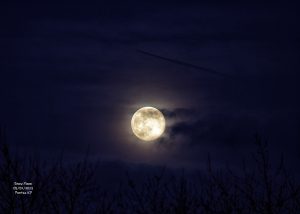Two superb images taken by member Jim Burchell of the planet Mercury and then of the planets Mercury & Venus on the 3rd April 2023.
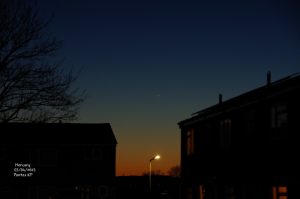
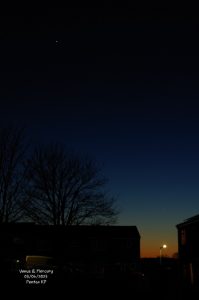
Astronomy every Thursday
This category will show a few lines from the last 3 items on the home page.
It will also show the full post on the news page
Two superb images taken by member Jim Burchell of the planet Mercury and then of the planets Mercury & Venus on the 3rd April 2023.


Two lovely images of a crescent Moon, with Earthshine and Venus taken by member Jim Burchell on the 24th March 2023. The first image has the ISS in it too!
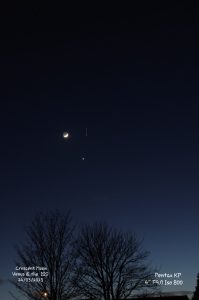
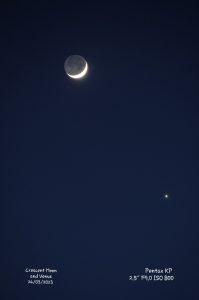
A selection of super images of the Full Moon taken on the 7th March 2023.
''In March, the Full Moon is the Worm Moon. It is also called Lenten Moon, Crow Moon, Crust Moon, Chaste Moon, Sugar Moon, and Sap Moon. The Worm Moon gets its name from the earthworms that come out when the soil warms up. The worms provide food for birds and other animals. It happens around the changing of the seasons, from astronomical winter to spring in the Northern Hemisphere.'' ref https://www.timeanddate.com/astronomy/moon/worm.html
This stunning very atmospheric image of the Full Worm Moon was taken by member Jim Burchell.
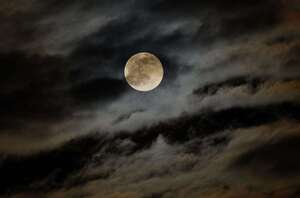
The next 3 beautiful images showing the Full Worm Moon rising were taken by member Honor Wheeler. Honor said ''Full Moonrise was not easy to capture tonight. The Moon barely escaped the cloud but got a few pics nonetheless.'' and yes she did :-)
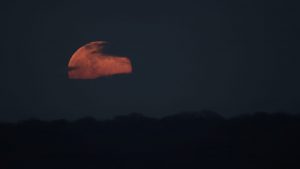
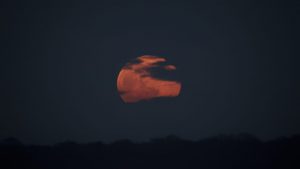

Member Jim Burchell was busy out and about towards the end of February photographing our stunning sky and below is a selection of his superb images.
Orion, Taurus and the Pleiades taken on the 23rd Feb from the CMHASD pavilion, Sutton-at-Hone.
Image was taken with a Pentax KP on a static tripod, F6.3, 30 sec, 18 MM and iso 800.
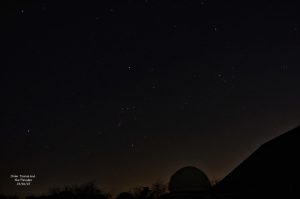
Crescent Moon on the 24th Feb.
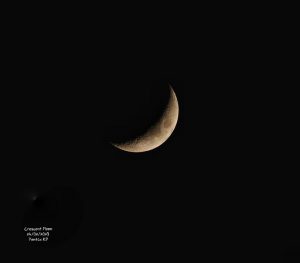
The Sun taken on the 24th Feb.
NEVER LOOK AT THE SUN DIRECTLY. Please see our Solar Observing safety page at crayfordmanorastro.com/solar-safety/
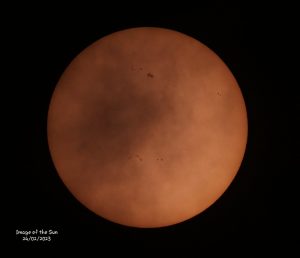
Crescent Moon with Jupiter & Venus on the 25th Feb.
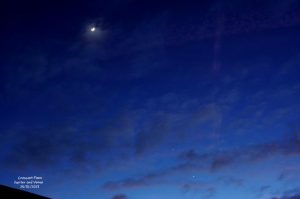
Updated: 19th February 2023
Exciting news!!!!!! An asteroid that had only been discovered in space a few hours before impacting the Earth has been caught by the Crayford (CMHASD) meteor camera on Monday 13th February 2023 at 2.59am.
It is only the seventh time an asteroid strike had been successfully forecast, in what the European Space Agency said was 'a sign of the rapid advancements in global asteroid detection capabilities'.
Despite all the cloud that was around at the time; our meteor camera managed to capture the small 1 meter asteroid now called 2023 CX1 as it entered the Earth’s atmosphere creating a brilliant fireball as it disintegrated, lighting up the night sky over the English Channel as it travelled eastward over the coast of Normandy, France. The 3ft meteoroid created an 'airburst' that could be seen across southern England and Wales and in parts of northern France as far south as Paris.
Below is the CMHASD meteor camera video showing the fireball.
[playlist type="video" ids="7557"]
The one-metre asteroid was discovered by Krisztián Sárneczky with the 60-cm Schmidt telescope of the Piszkéstető Observatory in Hungary. It is his second discovery of an impactor,
‘’The fireball event happened at the predicted time (02:59 UTC) and location, with observations mostly from Southern UK and France, but also from Belgium, the Netherlands and even Germany. It is likely that some fragments of the meteoroid may have survived the atmospheric pass and fell somewhere onshore close to the coast north of Rouen, in Normandy, France’’ ref: https://neo.ssa.esa.int/-/new-imminent-impactor-found-by-european-astronomer
Now a space rock (meteorite) from that fireball has been found in northern France and CMHASD are absolutely thrilled. On 15 February 2023 art student Loïs Leblanc found the first meteorite of 2023 CX1 in a field located in Saint-Pierre-le-Viger.
Update on Asteroid 2023 CX1 aka SAR2667 - YouTube
https://en.wikipedia.org/wiki/2023_CX1
More news still to follow - so do check back.
The latest image of the Green Comet C/2022 E3 (ZTF) that is currently gracing our skies by member George Buckberry. The photo was taken on the 14th February 2023 by George.
''Having spent months climbing up out of Corona Borealis and drifting past the Big and Little Dippers, like a rollercoaster car reaching its highest point, Comet C/2022 E3 ZTF has now gone 'over the top' of its path across the northern sky and is falling south, fading in brightness and shrinking in size as it drops towards Taurus. For northern hemisphere comet chasers and skywatchers E3’s show is almost over.'' ref https://www.skyatnightmagazine.com/advice/comet-c-2022-e3-ztf/
So well done George for capturing the Comet, you did well to get it as it's fading fast!
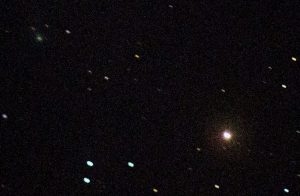
George has written on the image below of how he acquired the photo and the location of the star Aldebaran to the comet. Aldebaran (Alpha Tauri) is a bright red giant star in the constellation of Taurus.

Super image of Collinder 26 - the heart of the Heart Nebula (IC1805) in the constellation Cassiopeia; aptly taken by member and trustee Simon Dawes on the 14th February 2023.
The Heart Nebula's intense red output and its form are driven by the radiation emanating from a small group of stars near the nebula's center. This open cluster of stars, known as Collinder 26 or Melotte 15, contains some stars that are 50 times the mass of our Sun.
The Collinder catalogue is a catalogue of 471 open clusters compiled by Swedish astronomer Per Collinder.
Details of how Simon obtained the image are on the photo.
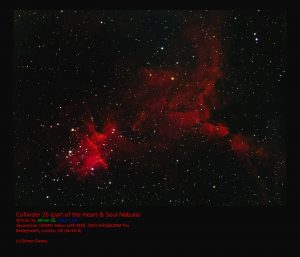
The California Nebula is an emission nebula located in the constellation Perseus not far from the Pleiades and near the star Xi Persei. The nebula’s signature reddish glow is thanks to this nearby star, Xi Persei, which is on the top, left side of the nebula in this image. This luminous blue star (also known as Menkib) is a blue giant that is over 12,000 times brighter than the sun. This massive star ionizes the hydrogen atoms in the California Nebula and is responsible for creating this iconic deep sky object.
The Nebula was discovered by E. E. Barnard in 1884 and its name comes from its resemblance to the shape of the US State of California. It is almost 2.5° long in the sky and roughly 1,500 light-years away from Earth.
Neil acquired the image using a WOGT71, EQ6 R, ZWO294MC, Optolong LEnhance filter, Astro Essentials 50mm Guide Scope, ZWO 290MM.
50x240s Subs, 12xDarks, 40xFlats/Bias.
Processed using APT, PHD, Nebulosity, Photoshop (Camera Raw), Gradient XTerminator.
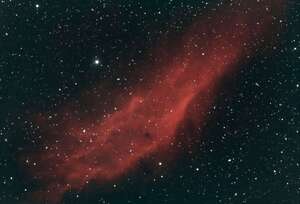
Check out Neil's Flickr page at https://www.flickr.com/photos/137388222@N05/
Member and trustee Martin Crow captured the Comet C/2022 E3 (ZTF) on the morning of the 18th January 2023 at 03:20am. The ion tail of the comet can be seen emerging at around the 2 o’clock angle in the photos.
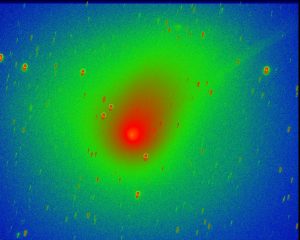
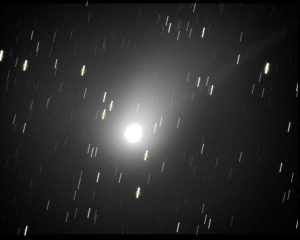
On the 5th February 2023, member Jim Burchell captured this absolutely beautiful image of the full moon also known as the Snow Moon. Jim took the photo using a Pentax KP, 300 mm, F7.1 1/25 sec and iso 400.
